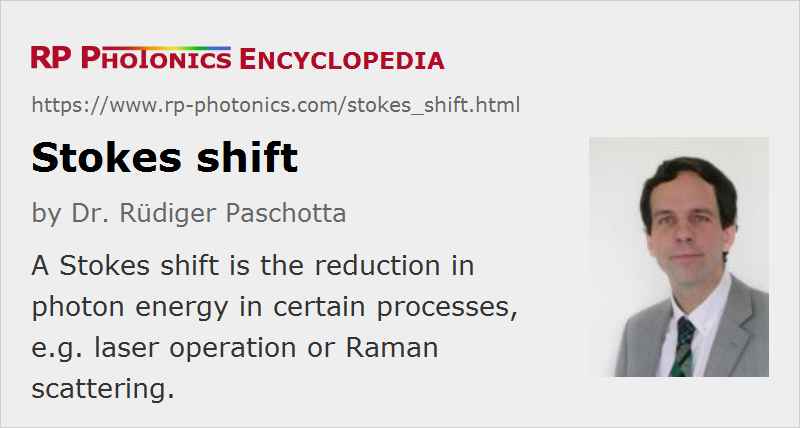Stokes Shift
Definition: the reduction in photon energy in certain processes
German: Stokes-Verschiebung
How to cite the article; suggest additional literature
Author: Dr. Rüdiger Paschotta
There are various kinds of optical processes where the resulting radiation has a decreased photon energy (or an increased wavelength) compared with the incoming radiation. Such a loss of photon energy is often called Stokes shift, referring to the Irish physicist George G. Stokes. Stokes shifts occur e.g. in the following cases:
- When some material is excited to emit fluorescence, the average photon energy of the fluorescent light is usually smaller than that of the incoming light, and the energy difference results in microscopic vibrations (heating). However, this is not always the case, see the article on optical refrigeration. The Stokes shift is always positive if it is defined via the absorption and emission band maxima for a given transition.
- The energy of photons emitted by an optically pumped laser is usually smaller than that of the pump radiation. The smallest possible Stokes shifts (→ quantum defect) for lasers (e.g. with ytterbium-doped gain media) correspond to less than 1% of the pump photon energy, but more usual values are between several percent and 40%.
- In Raman amplifiers and Raman lasers and also in devices based on Brillouin scattering, the photon energy of amplified light is also smaller than that of the pump light.
- In Raman spectroscopy, most of the scattered light has a reduced photon energy. Some anti-Stokes lines with increased photon energies can also often be detected.
Questions and Comments from Users
Here you can submit questions and comments. As far as they get accepted by the author, they will appear above this paragraph together with the author’s answer. The author will decide on acceptance based on certain criteria. Essentially, the issue must be of sufficiently broad interest.
Please do not enter personal data here; we would otherwise delete it soon. (See also our privacy declaration.) If you wish to receive personal feedback or consultancy from the author, please contact him e.g. via e-mail.
By submitting the information, you give your consent to the potential publication of your inputs on our website according to our rules. (If you later retract your consent, we will delete those inputs.) As your inputs are first reviewed by the author, they may be published with some delay.
See also: photons, fluorescence, Raman amplifiers
and other articles in the category nonlinear optics
 |



If you like this page, please share the link with your friends and colleagues, e.g. via social media:
These sharing buttons are implemented in a privacy-friendly way!